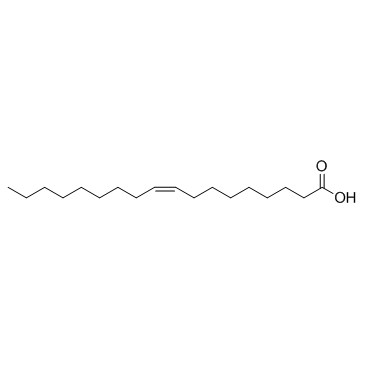Oleic acid (9-cis-Octadecenoic acid) (Synonyms: 9Z-Octadecenoic Acid, C18:1(9Z), cis-9-Octadecenoic acid) |
| Catalog No.GC30110 |
Oleic acid (9-cis-Octadecenoic acid) (9-cis-Octadecenoic acid) is an abundant monounsaturated fatty acid.
Products are for research use only. Not for human use. We do not sell to patients.

Cas No.: 112-80-1
Sample solution is provided at 25 µL, 10mM.
Oleic acid (9-cis-Octadecenoic acid) is a monounsaturated Omega-9 fatty acid found in plants and animals[1]. It is a Na+/K+ ATPase activator[2].
Oleic acid (9-cis-Octadecenoic acid) or EPA treatment alone inhibited cell viability, similar to PA treatment, but PA and OA (PA+OA) or combined PA and EPA (PA+EPA) treatment increased cell viability in HepG2 cells compared with PA treatment alone PA+OA.The growth and proliferation effects of the treatment are consistent with previous observations that Oleic acid (9-cis-Octadecenoic acid) attenuates PA-induced apoptosis through OA-activated autophagy[4]. Oleic acid (9-cis-Octadecenoic acid) and palmitic acid can induce lipid deposition in HepG2 cells and increase expression of every component of mTOR/S6K1/SREBP-1c pathway[3]. Oleic acid (9-cis-Octadecenoic acid) caused a concentration- and time-dependent damage with typical apoptotic features in cortical and hippocampal cultures from embryonic and neonatal rats, respectively, as well as in human neuroblastoma SH-SY5Y cells[7].
Oleic acid (9-cis-Octadecenoic acid) in semisolids, especially Pemulen TR2-based ones, presented suitable characteristics for cutaneous administration and its anti-inflammatory activity seems to occur via glucocorticoid receptors. Oleic acid (9-cis-Octadecenoic acid) was also capable to reduce croton oil-induced skin inflammation. Besides, the ex vivo skin permeation study indicated that OA reaches the receptor medium, which correlates with a systemic absorption in vivo[5].In mice,the reduction of dopamine and oxidant effect during cytarabine treatment could result in brain injury but could be prevented by Oleic acid (9-cis-Octadecenoic acid)supplementation[6].
References:
[1]: Jack-Hays MG, Xie Z, et,al. Activation of Na+/K(+)-ATPase by fatty acids, acylglycerols, and related amphiphiles: structure-activity relationship. Biochim Biophys Acta. 1996 Feb 21;1279(1):43-8. doi: 10.1016/0005-2736(95)00245-6. PMID: 8624359.
[2]: Li S, Zhou T, et,al.High metastaticgastric and breast cancer cells consume oleic acid in an AMPK dependent manner. PLoS One. 2014 May 13;9(5):e97330. doi: 10.1371/journal.pone.0097330. PMID: 24823908; PMCID: PMC4019637.
[3]: Zhou YP, Wu R, et,al. [Comparison of effects of oleic acid and palmitic acid on lipid deposition and mTOR / S6K1 / SREBP-1c pathway in HepG2 cells]. Zhonghua Gan Zang Bing Za Zhi. 2018 Jun 20;26(6):451-456. Chinese. doi: 10.3760/cma.j.issn.1007-3418.2018.06.012. PMID: 30317760.
[4]: Sun Y, Wang J, et,al.Oleic Acid and Eicosapentaenoic Acid Reverse Palmitic Acid-induced Insulin Resistance in Human HepG2 Cells via the Reactive Oxygen Species/JUN Pathway. Genomics Proteomics Bioinformatics. 2021 Oct;19(5):754-771. doi: 10.1016/j.gpb.2019.06.005. Epub 2021 Feb 23. PMID: 33631425; PMCID: PMC9170756.
[5]: Pegoraro NS, Camponogara C, et,al.Oleic acid-containing semisolid dosage forms exhibit in vivo anti-inflammatory effect via glucocorticoid receptor in a UVB radiation-induced skin inflammation model. Inflammopharmacology. 2020 Jun;28(3):773-786. doi: 10.1007/s10787-019-00675-5. Epub 2019 Dec 4. PMID: 31802387.
[6]: GuzmÁn DC, Brizuela NO, et,al. Oleic Acid Protects Against Oxidative Stress Exacerbated by Cytarabine and Doxorubicin in Rat Brain. Anticancer Agents Med Chem. 2016;16(11):1491-1495. doi: 10.2174/1871520615666160504093652. PMID: 27141883.
[7]: Zhu Y, Schwarz S, et,al.Oleic acid causes apoptosis and dephosphorylates Bad. Neurochem Int. 2005 Jan;46(2):127-35. doi: 10.1016/j.neuint.2004.08.003. PMID: 15627513.
Average Rating: 5 (Based on Reviews and 36 reference(s) in Google Scholar.)
GLPBIO products are for RESEARCH USE ONLY. Please make sure your review or question is research based.
Required fields are marked with *




